Product pictures
| Amount Per 1 cup, 221 g | |||
| Calories | 90 Kcal (377 kJ) | ||
| Calories from fat | 9 Kcal | ||
| % Daily Value* | |||
| Total Fat | 1g | 2% | |
|---|---|---|---|
| Cholesterol | 3mg | 1% | |
| Sodium | 390mg | 16% | |
| Total Carbs | 19g | 6% | |
| Sugars | 7g | 28% | |
| Dietary Fiber | 3g | 12% | |
| Protein | 3g | 6% | |
| Vitamin A | 0.1mg | 4% | |
| Iron | 0.6mg | 3% | |
| Calcium | 80mg | 8% | |
* Percent Daily Values are based on a 2000 calorie diet. Your daily values may be higher or lower depending on your calorie needs.
Find out how many calories should you eat.
Ingredients And Nutrition Overview
Best
choice Good
choice Poor
choice Avoid
it!
choice Good
choice Poor
choice Avoid
it!
-
WeightWatchers Points: 1.3, PointsPlus: 2, SmartPoints: 3
WeightWatchers Points are estimated by carbohydrates, fats, protein and fiber in product. They are not an affirmation of better quality or nutritional value of the product or its manufacturer. Only way to count for dieters. Less points are better.
Read more at Weight watchers diet review -
Salty! Has over 16% of the daily sodium max
The average American consumes 5,000 mg of sodium daily — twice the recommended amount amount of 2400mg for healthy adults, this is 1 teaspoon of salt.
For medical reasons many people should not exceed 1500mg of sodium.
Surprisingly, you're responsible for only 15% of the sodium in your diet the bigger part - 75% of the sodium that you consume each day comes from processed foods, not home cooking or the salt shaker.
Excess sodium intake increases the risk of high blood pressure, hypernatremia, hypertension, cardiovascular disease and other heart problems.
Are these reasons enough to cut the sodium intake? No doubt! -
Convert Salt tsps to Sodium mg easily
Salt (NaCl) is not excactly sodium (Na).
It is not right to use these terms as synonyms.
The FDA recommended limit of sodium is 2,300 mg per day (or even less - about 1500 mg while one is on low sodium diets).
This is much less than the weight of salt.
(5,750 mg per day or 3,750 mg for low sodium diet) and not so convenient to calculate.
Know how much sodium is in your salt - without a calculator:
1/4 tsp salt = 600 mg sodium
1/2 tsp salt = 1200 mg sodium
3/4 tsp salt = 1800 mg sodium
1 tsp salt = 2300 mg sodium -
3 tsp of sugars per serving
This volume includes both naturally occurring from ingredients and specially added sugars.
USDA tells us that last years each American consumed an average 130 pounds of caloric sweeteners per year!
That works out to 30 tsp of sugars per day approximately 480 extra calories!
Just to think: Eating just 200 more calories daily than your body requires for body functioning and exercise leads to a 20-pound weight gain in a year. -
Great source of fiber! More than 12% daily!
Eat more fiber. You've heard it many times. But why it is so good for your health?
Dietary fiber is best known for its ability to make our digestion going right.
So want to prevent or relieve constipation - eat more fiber!
There are also other great health benefits as well, such as lowering your risk of diabetes, heart disease and cancer, and helping to maintain a healthy weight by helping to feel you full longer.
The best source of fiber are fruits, vegetables, whole grains and legumes and not processed foods with added fiber. -
Not a really good source of calcium!
Cheese is a generally a good source of calcium (more than 10% daily value per serving) - but not this.
If you are looking for calcium - swap for something with higher calcium content.
By the way, you don't need high fat or calories to get high calcium.
Many "lite" versions of cheese provide 30% of daily calcium needs.
Choose cheeses that are a naturally good source of calcium.
If you're worried about fat and calories, pre-sliced cheese, cheese sticks or cheese squares
are a great way to make sure your portion is the right size.
The FDA defines a serving of cheese as 1 ounce (30 grams). -
For dieters: FoodPoints value is 2
* FoodPoints are calculated by Fooducate based on fats, carbs, fiber, and protein. They are not an endorsement or approval of the product or its manufacturer. The fewer points - the better.
-
Highly Processed!
This product is highly processed. If you'll take a look at its ingredient list, you'll discover new words to add to your vocabulary. Many of theses ingredients are required to increase the shelf life of the product and improve the flavor that disappears when food is not fresh.
-
Natural flavors added. Learn why
Companies add flavorings to make products taste better. They are created in a lab and the formulations are guarded as trade secrets. Flavorings can compensate for flavor loss during processing, substitute for ingredients, lower production costs and increase shelf stability. Natural flavorings are more expensive to source than artificial flavors, but tend to be better received by consumers. People sensitive to MSG, vegans, vegetarians and those with allergies should pay special attention to the phrase "natural flavorings" since glutamates, animal products or allergens may be the source of natural flavors. You can always contact the manufacturer for more information.
-
Calcium chloride and waste reduction...
Calcium chloride is thought of as OK for your health, though some advise that it could cause slight stomach irritation. When used as an additive in products like jellies or cheeses, it causes the food to firm up. When used in tomato-based products it prevents disintegration. It also adds a tiny bit of saltiness without adding sodium. This additive is a by-product of The Solvay process. In this process, carbon dioxide is mixed with table salt and ammonia to create soda ash (or potash) and other products, like baking soda. One of the problems is that this process produces waste - a lot of waste. As a result of this and other technological advances, the last Solvay plant in the US closed in 1986. But the process continues in other parts of the world. While more and more calcium chloride is removed from the waste in settling ponds or dumped directly into the sea, the issue of what to do with this by-product is still relevant. By using calcium chloride as a food additive, manufacturers are actually reducing the amount of waste that is put back into the environment. Whether this is a "reuse" effort you want to be a part of is up to you . . .
Allergens
Lactose Allergy, Milk Allergy, Wheat Allergy, Gluten Allergy, Soy Allergy, Eggs Allergy, Corn Allergy
Soup cheese tortellini Ingredients
Water, Tomatoes (Tomatoes, Tomato Juice, Calcium Chloride, Citric Acid), Tomato Puree, Cheese Tortellini Pasta (Water, Whole Wheat Flour, Durum Flour, Ricotta Cheese [Pasteurized Whey, Milk-Fat and Milk], Parmesan Cheese [Pasteurized Part Skim Milk, Cheese Cultures, Salt, Enzymes], Romano Cheese [Pasteurized Cow's Milk, Cheese Cultures, Salt, Enzymes], Baked Wheat Flour [Wheat Flour, Sugar, Soybean Oil, Yeast], Whole Eggs, Provolone Cheese [Pasteurized Whole Milk, Cheese Culture, Salt, Enzymes], Egg Whites, Salt, Black Pepper), Contains Less than 2% of the Following: Corn Starch, Mirepoix Base (Sauteed Vegetable [Carrots, Celery, Onions], Evaporated Cane Juice, Soybean Oil, Sea Salt, Corn Starch, Natural Flavorings), Dehydrated Onion, Sugar, Basil, Salt, Garlic Powder, Natural Flavor, Onion Powder.
You Might Also Like
% RDI of Main Nutrition Facts
5%
of RDI* (90 calories) 221 g
-
Cal: 4.5 %
-
Fat: 1.5 %
-
Carb: 6.3 %
-
Prot: 6 %
-
0%25%75%RDI norm*
Calories Breakdown
- Carbs (78.4%)
- Fat (9.3%)
- Protein (12.4%)
Get Your Recipe of Health!
Follow RecipeOfHealth on Facebook!

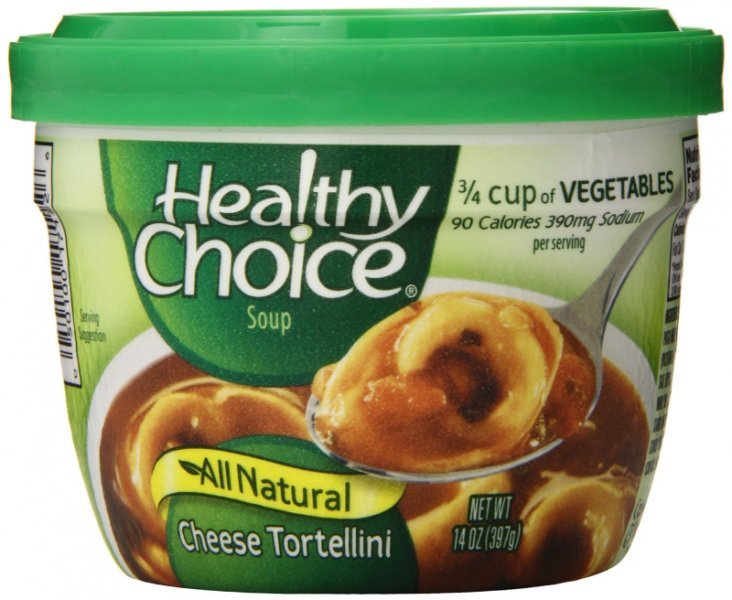
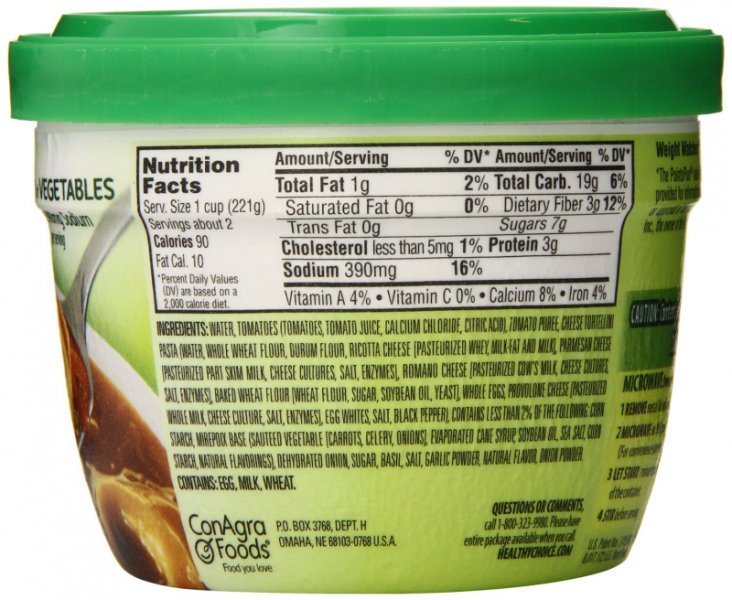
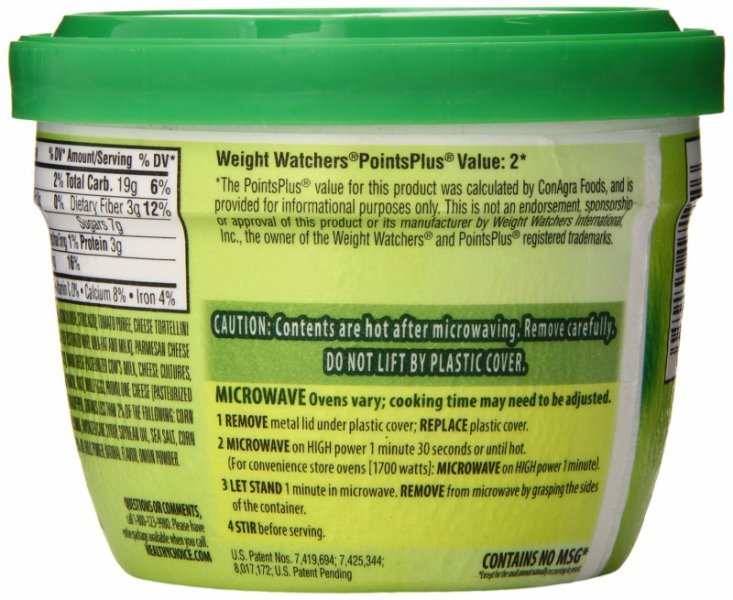
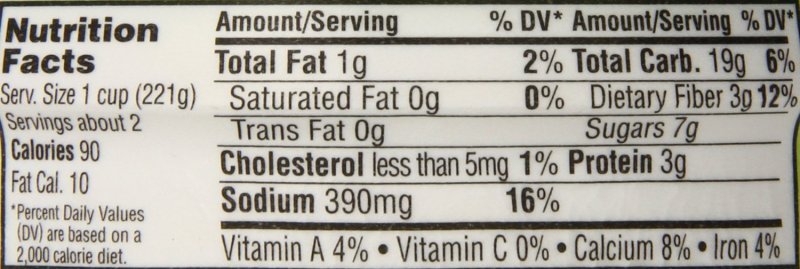
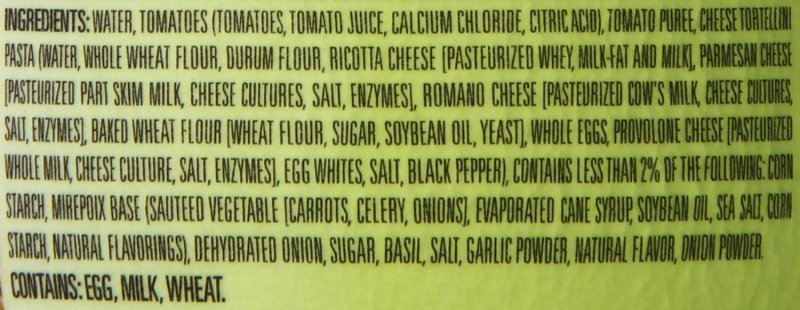










Add your comment